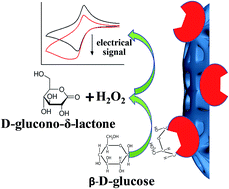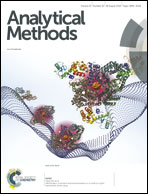Dual function hollow structured mesoporous Prussian blue mesocrystals for glucose biosensors
Abstract
Hollow structured mesoporous materials have attracted great interest in recent years. We present a new glucose biosensor based on dual function hollow structured mesoporous Prussian Blue (PB) mesocrystals (HMPB). HMPB serve as both a scaffold carrier matrix to immobilize the enzyme glucose oxidase (GOx-HMPB) on the electrode and as a redox mediator to H2O2, the by-product of GOx catalyzed glucose reaction. The Barrett–Joyner–Halenda (BJH) calculation based on nitrogen adsorption isotherm measurement indicates a ∼20 nm mesoporous outer shell and a ∼60 nm hollow cavity of HMPB that provide a large area (258 m2 g−1) for GOx loading. The larger surface area of HMPB compared to solid PB makes it much easier to reduce the HMPB at lower applied potential (0.130 V). The HMPB display enhanced sensitivity towards glucose detection due to increased GOx loading and increased catalytic sites of HMPB with the linear detection range from 0.05 to 7.3 mM, a limit of detection of 0.04 mM (S/N = 3) and a fast response time (within 6 s). The detected glucose level in human serum samples is in good agreement with the data from hospital clinical measurements. The data demonstrate that the HMPB mesocrystals acted effectively as both a redox mediator to H2O2 and a good enzyme carrier, suggesting that the strategy can be applied to other electroactive hollow mesoporous materials to prepare simplified biosensors for a wide range of clinical applications.



 Please wait while we load your content...
Please wait while we load your content...